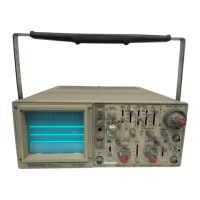USING
DELAYED
SWEEP
FOR MEASUREMENT OF
RISETIMES AND FALLTIMES
Risetimes
and falltimes are generally measured by using the
10% and 90% amplitude points as reference starting and
ending points for the rise or fall.
1.
Apply the signal to the INPUT jack and set the vertical
MODE to the channel to be
used.
Use
the VOLTS/DIV and
VARIABLE
controls to obtain a
normal 6 divisions vertical amplitude waveform.
Using
the • POSITION control, set the waveform
posi-
tion
in the central area of the
screen
vertically,
that
it to
coincide
with
the 100% and 0% lines on the CRT
screen.
Set
the
SWEEP
TIME/DIV control to as high a speed as
possible
consistent
with
observatin of both the 10%
and 90% points.
Set
the
SWEEP
VARIABLE
to CAL position.
2.
Set the B TRIG MODE to initiate the
AFTER
DELAY
mode of operation and HORIZ MODE to INT and adjust
the B
SWEEP
TIME/DIV for as short as possible an inten-
sified
section of waveform.
3.
Using the
DELAY
TIME MULT, adjust the waveform
such
that
the 10% point is intensified and record the
dial reading.
4. Similarly, using the
DELAY
TIME MULT, adjust the 90%
point so
that
it is intensified and record
that
dial reading
as
well.
The
pulse risetime (or falltime) is simply the difference
between the two dial settings times the A
SWEEP
TIME/DIV control setting.
Using
the formula:
Risetime
= (2nd dial reading — 1st dial reading) x Delayed
sweep
time
(A
SWEEP
TIME/DIV setting)
TIME DIFFERENCE MEASUREMENTS
USING
DELAYED
SWEEP
Synchronized
waveforms which are skewed in
time
can be
accurately
measured using the delayed sweep.
1.
Apply the two signals to the CH1 and CH2 INPUT
jacks
setting the vertical MODE to DUAL and selecting either
ALT
or CHOP display.
2.
Set the
SOURCE
to the signal
that
is leading in phase
and adjust VOLTS/DIV and
SWEEP
TIME/DIV for
easy
waveform observation.
Set
the
SWEEP
VARIABLE
control to CAL position.
3.
Set the B TRIG MODE to initiate the
AFTER
DELAY
mode of operation. Set the HORIZ MODE to INT and ad-
just
the B
SWEEP
TIME/DIV and
DELAY
TIME MULT to
make the intensified portion coincide
with
the rising
edge or falling edge of the waveform
that
is to be used
as
the reference.
4. Set the HORIZ MODE to ALT and use the
TRACE
SEPARATION
control to adjust the B sweep for
easy
observation.
5. Using the
DELAY
TIME MULT adjust the pulse to any
convenient
vertical graduation line and record the dial
reading at
that
point.
6. Using the
DELAY
TIME MULT adjust the corresponding
point on the second signal to the same vertical line and
record
the reading of the dial at this point as well. The
time
difference or skew of the two waveforms is then
the second dial reading minus the first dial reading
multiplied by the A
SWEEP
TIME/DIV control setting.
Using
the formula:
Time difference = (2nd dial reading — 1st dial reading)
x Delayed sweep
time
(A
SWEEP
TIME/
DIV setting).
Fig.
37
Fig.
38
[EXAMPLE]
For
the example, the first dial reading is 1.20 (10% point)
and the second is 7.38 (90% point)
with
the A
SWEEP
TIME/DIV set at 2 /ts. (See Fig. 37)
Substituting the given value:
Risetime
= (7.38
-1.20)
x 2
(^=12.36
(is
[EXAMPLE]
The
reference signal dial reading is 1.00 while the second
dial reading is 5.34
with
an A
SWEEP
TIME/DIV setting of
2
(is. (See Fig. 38)
Substituting the value:
Time difference =
(5.34-1.00)
x 2 (/*s) = 8.68 /ts
29
-Rise
time
Read the dial setting when
-B
sweep points
of
DELAY
"TIME
MULT
©
and
©
are
in the same position.

